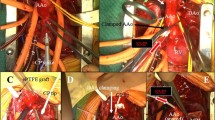Abstract
We report the anesthetic management of a 7-month-old male infant with severe aortic regurgitation (AR) scheduled for the Ross procedure. To the best of our knowledge, this is the first report from the viewpoint of anesthetic management for the Ross procedure performed in an infant. He had been suffering from severe AR that occurred suddenly when he was 5 months old. The cause of the AR was considered to be spontaneous rupture of a fenestrated aortic valve, owing to congenital tissue defect in part of the aortic valvular leaflet. The Ross procedure was scheduled to be performed under general anesthesia using deep hypothermic cardiopulmonary bypass (CPB). Continuous infusion of nitroglycerin was started during CPB and continued after CPB to dilate the newly implanted coronary arteries for the prevention of myocardial ischemia and to decrease afterload and pulmonary vascular resistance. Weaning from CPB was performed without difficulty, but after the prolonged CPB he had a bleeding tendency that needed transfusion and a hemostatic drug. Monitoring with transesophageal echocardiography was very useful for evaluating myocardial ischemia, and for assessing the procedure and the completion of surgical repair. His postoperative course was uneventful and he was discharged on the 25th postoperative day.
Similar content being viewed by others
References
Ross DN. Replacement of aortic and mitral valves with a pulmonary autograft. Lancet. 1967;2:956–958.
Kobayashi M, Takahashi Y, Ando M, Wada N, Murata M, Kikuchi T. Ross procedure in an infant weighing 4.5 kg. Jpn J Thorac Cardiovasc Surg. 2005;53:635–637.
Sanker NM, Goel P, Agarwal H, Srinivas S, Cherian KM. Ross procedure in an infant. Indian Heart J. 2001;53:346–347.
Osaki S, Kawada M, Ishino K, Sano S. Neonatal Ross procedure for congenital aortic regurgitation: a case report (in Japanese with English abstract). Nihon Shouni Junkanki Gakkai Zasshi (Pediatric Cardiology and Cardiac Surgery). 2006;22:23–25.
Friedman B, Hathaway BM. Fenestration of the semilunar cusps, and “functional” aortic and pulmonic valve insufficiency. Am J Med. 1958;24:549–558.
Foxe AN. Fenestrations of the semilunar valves. Am J Pathol. 1929;5:179–182.
Moran SV, Casanegra P, Maturana G, Dubernet J. Spontaneous rupture of a fenestrated aortic valve. J Thorac Cardiovasc Surg. 1977;73:716–718.
Blaszyk H, Witkiewicz AJ, Edwards WD. Acute aortic regurgitation due to spontaneous rupture of a fenestrated cusp: report in a 65-year-old man and review of seven additional cases. Cardiovasc Pathol. 1999;8:213–216.
Akiyama K, Ohsawa S, Hirota J, Takiguchi M. Massive aortic regurgitation by spontaneous rupture of a fibrous strand in a fenestrated aortic valve. J Heart Valve Dis. 1998;7:521–523.
Marcus FI, Ronan J, Misanik LF, Ewy GA. Aortic insufficiency secondary to spontaneous rupture of a fenestrated leaflet. Am Heart J. 1963;66:675–678.
Bailey CP, Brest AN, Dontas N, Uricchio JF. Successful surgical repair of aortic insufficiency due to valvular fenestration. Circulation. 1959;20:587–589.
Nagano H, Kawahito K, Tanaka M. Acute aortic regurgitation by spontaneous rupture of a fibrous strand in fenestrated aortic valve; report of a case (in Japanese with English abstract). Kyobu Geka (Thoracic Surgery). 2006;59:940–942.
Al-Halees Z, Pieters F, Qadoura F, Shahid M, Al-Amri M, Al-Fadley F. The Ross procedure is the procedure of choice for congenital aortic valve disease. J Thorac Cardiovasc Surg. 2002;123:437–441.
Hraska V, Krajci M, Haun C, Ntalakoura K, Razek V, Lacour-Gayet F, Weil J, Reichenspurner H. Ross and Ross-Konno procedure in children and adolescents: mid-term results. Eur J Cardiothorac Surg. 2004;25:742–747.
Pavlovic M, Schaller A, Ammann RA, Pfammater JP, Berdat P, Carrel T, Gallati S. Sodium pump reduction correlates with aortic clamp time in pediatric heart surgery. Exp Biol Med. 2006;231:1300–1305.
Marino BS, Pasquali SK. Wernovsky G, Rychik J, Montenegro L, Shera D, Spray TL, Cohen MS, Pudusseri A. Accuracy of intraoperative transesophageal echocardiography in the prediction of future neo-aortic valve function after the Ross procedure in children and young adults. Congenit Heart Dis. 2008;3:39–46.
Gomez CB, Stutzbach PG, Guevara E, Favaloro RR. Does intraoperative transesophageal echocardiography predict pulmonary valve dysfunction during the Ross procedure? J Cardiothorac Vasc Anesth. 2002;16:437–440.
Author information
Authors and Affiliations
About this article
Cite this article
Watabe, A., Saito, H., Harasawa, K. et al. Anesthetic management for severe aortic regurgitation in an infant repaired by Ross procedure. J Anesth 23, 270–274 (2009). https://doi.org/10.1007/s00540-008-0718-z
Received:
Accepted:
Published:
Issue Date:
DOI: https://doi.org/10.1007/s00540-008-0718-z




